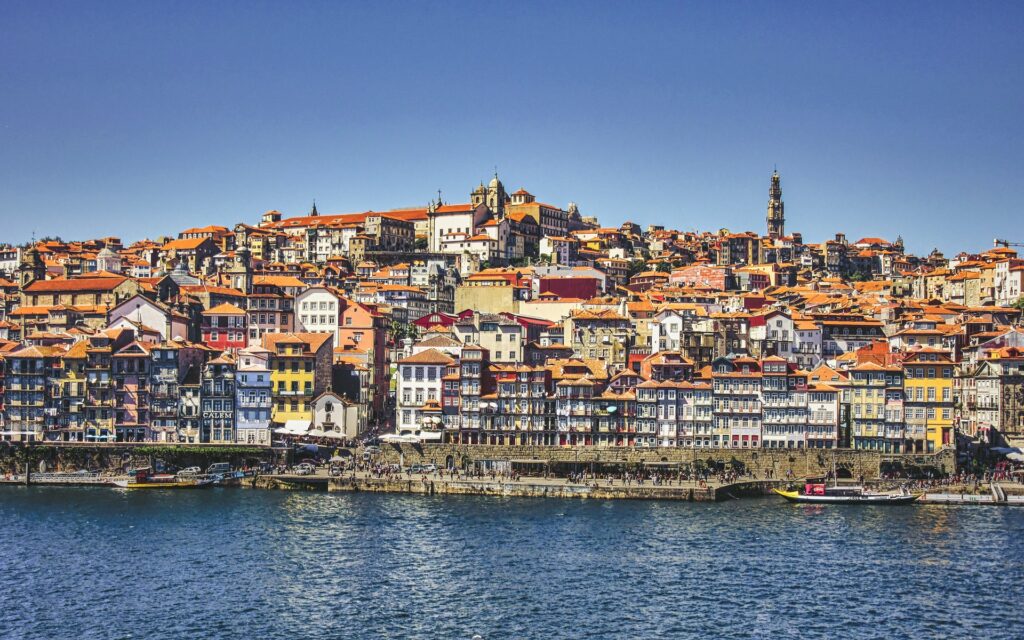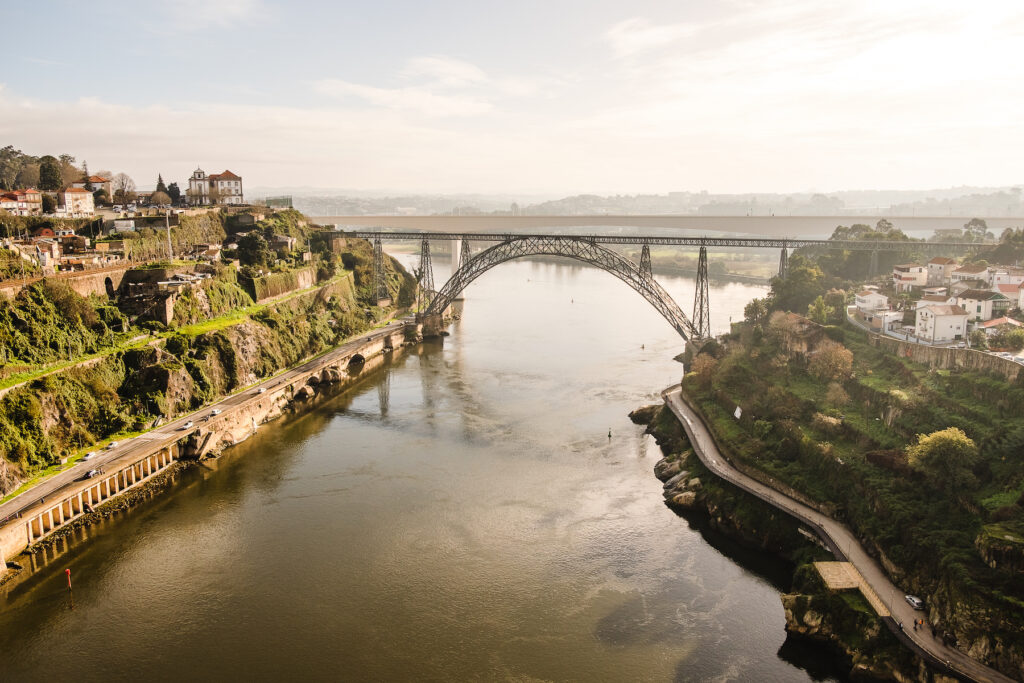Here you can find answers to all of the commonly asked questions from visitors to Porto. If you have questions for which you can’t find an answer on the site, drop us a message and we’ll be happy to help.
Q: Porto? Where’s that?
A: Porto is located on the coast of Portugal, next to the Atlantic Ocean. It is 200 miles north of the capital city of Lisbon and 100 miles south of Portugal’s border with Spain. It’s also 350 miles west of Madrid. It is the largest city in the northwest of the Iberian peninsula. It is found on the mouth of the Douro river and its wine region. Port wine, as well as Douro table wine, is one of Porto’s famous exports and is produced along the river and stored in Porto (or more precisely in its twin city, across the Douro river, Gaia).
Q: Sounds good! When is the best time to visit?
A: Summer is pleasantly hot and dry, but with foggy mornings and breezy evenings — think London mornings, Mediterranean afternoons, and French-riviera evenings. Expect highs in the mid- to upper-seventies and lows in the upper-fifties. Also expect low humidity and little rain. So pack light if going to Porto in the Summer but don’t forget a sweater or light jacket to wear in the evenings. Late Spring, with highs around 70 and lows in the mid-fifties, is also an excellent time to visit. On June 23rd, Porto stops for the St. John’s festival, the city’s own Mardi Gras. Prices in Porto change little with the seasons, so a summer stay offers the best of both worlds if you like warm weather. In August, however, Porto is for the most part abandoned by locals and filled with tourists. Early Autumn is also a good option. In October, expect highs around 70 and lows in the lower-fifties. Some rain, but not much. Also, you’ll have the added buzz of the new academic year at Porto’s university. Bring an umbrella just in case for the occasional shower. From November till April you risk getting some — maybe a lot of — rain. The North of Portugal (and of Spain; basically the Northern half of the Iberian peninsula) is particularly wet. So this is not the best time to visit Porto. And although April is already sunny and warm in the Southern half of Portugal, the North delays its escape from wintry weather till the beginning of May. It never snows in Porto. Still, with very humid Winters, lows in the low-forties can feel very cold. Highs in December-January reach into mid-fifties, which is not that bad. Very often, all a December day requires is a wool sweater and a wind-breaking jacket.
Q. What would you recommend for a one week itinerary in Porto?
A. This depends entirely on the sort of person you are.
Q: What sort of opening hours should I expect?
A: Like most European cities, the majority of Portuguese locals in Porto will wake up at around 7:00am, start work at 9:00am, have a one hour lunch break between 11:00am and 2:00pm, finish work at around 6:00pm, have dinner at 8:00pm or 9:00pm and go to bed at around 11:00pm. Bars, however, stay open until at least 2:00am during the week and until 5:00am on Friday and Saturday.
You’ll find that most shops close between 12:00 and 2:00pm for a Siesta, though banks will stay open from 8:30am until 3:00pm. Most shops also open on Saturday mornings until 1:00pm and close on Sunday. Stores located in shopping malls are usually open seven days a week between 10:00am and 11:00pm.
Most museums and monuments are closed on Mondays.
Q: Are there any public holidays I should be aware of?
A: Plenty. And things really stop whenever there is one. Moreover, whenever one falls on a Tuesday or Thursday, the day connecting it to the closest weekend becomes aponte (bridge), and many locals take off for a long weekend. Bye-bye productivity; enter quality of life. Here is a list of official holidays:
- January 1 — Dia de Ano Novo;
- Ash Tuesday (February/March) — Carnaval;
- Good Friday (March/April) — Sexta Feira Santa;
- April 25 Liberty Day, commemorating the 1974 Democratic Revolution — Dia Vinte Cinco de Abril;
- May 1 Labor Day — Dia do Trabalhador;
- Corpus Christi (late-May/early-June) — Corpo de Deus;
- June 10 Portugal Day — Dia de Portugal;
- June 24 St. John’s Day, celebrating Porto’s patron saint — Dia de S. Joao;
- August 15 Assumption Day — Festa da Assunção;
- October 5 Republic Day, commemorating the 1910 Republican Revolution — Dia da Instauração da República;
- November 1 All Saints’ Day — Dia de Todos os Santos;
- December 1, commemorating restoration of independence from Spain in 1640 — Dia da Restauração;
- December 8 Immaculate Conception — Dia da Imaculada Conceicao;
- December 25 Christmas Day — Natal.
Q: Are there any exciting festivals?
A: Yes. Porto celebrates St. John, its patron saint, on the night of June 23rd to June 24th. This means there are thousands of people on the streets, dancing, drinking, talking to strangers, and having a good time. If you like Mardi Gras’ style festivals, you’ll love it; otherwise, visit at another time.
Q: So, how long should I spend in Porto?
A: Porto will keep you busy and happy for at least three days. If you throw in a couple of daytrips around Northern Portugal, you could easily do a full week here without feeling like you’re wasting your time. The perfect Porto-centric vacation would be three days in town, a few daytrips — to Guimaraes, Amarante, Viana do Castelo, and Santiago de Compostela in Northern Spain — and then a handful of days enjoying the Douro wine country, for a total of 10-14 days.
Q: And what’s the best way to get there?
A: You can fly in, take a train there, or drive to Porto.
If you’re coming to Porto directly from abroad, flying is the best option. Porto is directly connected daily to most European capitals and also bi-weekly to New York City. You will arrive at the Francisco de Sá Carneiro airport. From there, the most convenient way to get downtown is to take a taxi (25-30 euros, depending on traffic conditions). You can also take the metro directly at the airport and pay 2 euros to get to the city. Or you can take the direct buses of the Aerobus line (22.507.1054 / http://www.stcp.pt). Just walk out from the arrivals lounge and wait for one, they stop every 30 minutes between 6:45am and 7:15pm. Aerobuses stop at the major hotels and cost 4 euros each way.
If you’re coming from Lisbon, the train is probably your best option. (Traffic on the main A1 highway in Portugal is heavy and there’s a lot of road-rage, so we don’t recommend driving from Lisbon.) You should go for the Alfa Pendular trains, which take about three hours to cover the 200 miles between the two cities. Fare in coach is around 25 euros each way. Trains from the South (including Lisbon) arrive at the Campanha station. From there you can take the metro (1 euro) or a taxi (5 euros) downtown. For rail information, check with the Portuguese train company CP (80.820.8208 / http://www.cp.pt). Trains to the Douro valley depart from the downtown station S. Bento, which is a sightseeing attraction in and of itself.
If for any reason you’re traveling by car between Lisbon and Porto, count on three hours to cover the 200-mile distance. Porto is the road hub of Northern Portugal, so you’ll be able to take plenty of day-trips from there. The city is encircled by VCI, which connects to all major highways. If you’re coming from the south, the easiest way of getting downtown is to follow the Porto West directions, take a right as soon as you cross the Douro river on the Arrabida bridge, and then follow the directions downtown — you should be therein 20-30 minutes. Traffic in Porto is usually very heavy during the day. It is not uncommon to take one hour or more to cover a few miles, especially during the holiday season. (August is an exception, as most people are vacationing somewhere else.) Since buses and taxis use their own express lanes on most major streets, you’ll be much happier — and arrive more punctually — if you use public transportation.
Q: Should I rent a car or is public transportation OK?
A: We strongly recommend using public transportation while in Porto. Renting a car, however, is essential for daytrips. What you can do is rent a car for a driving tour in Northern Portugal then return it and use public transportation for your stay in Porto. Use the metro (22.508.1000 / http://www.metrodoporto.pt/) whenever possible (between 0.85 and 1.6 euros); take taxis whenever the metro is not an option. (The metro stops at the airport and at the main train station — Campanha — so you can always use it when arriving in, and departing from, Porto.) Taxi services are quite inexpensive in Porto. A taxi from downtown to Foz (the seafront) should cost you between 7 and 10 euros, depending on traffic. From the airport to downtown, count on 25-30 euros. Taxis are more or less available everywhere — OK, it is not like NYC, but you’ll probably have an easy time hailing one. You can always call 22.502.1132 to order one immediately or make a reservation. Walking is also a good way of getting around within each neighborhood.
Q: How safe is Porto? Can I travel there as a solo female?
A: Porto is a pretty safe city and perfect for solo female travellers too. Using common sense and behaving how you would at home will help
Use general street-smart criteria for big cities: walk whenever other people are present, don’t use alleys or cross parks after sunset, etc. Although there is not much major crime, pick-pocketing may be a problem, particularly in the more traditional neighborhoods like Ribeira and downtown. As always, common sense will help. Pay attention to your belongings, don’t carry foot-long photographic lenses in isolated places while you consult a map with a bewildered look, and don’t do anything stupid, like getting into a stranger’s car just because he stopped by and asked you if you wanted a ride even though you were not hitch-hiking.
Q: Should I tip while in Porto? How much is appropriate?
A: Unlike the United States, there isn’t much of a tipping culture in restaurants or otherwise in Europe — Portugal, and Porto, is much the same. You should tip around 10% in restaurants around the city and if you receive excellent service then feel free to tip more. For taxis you can tip however much you like. We usually recommend rounding the fare up to the nearest €5 and telling them to keep the change.


